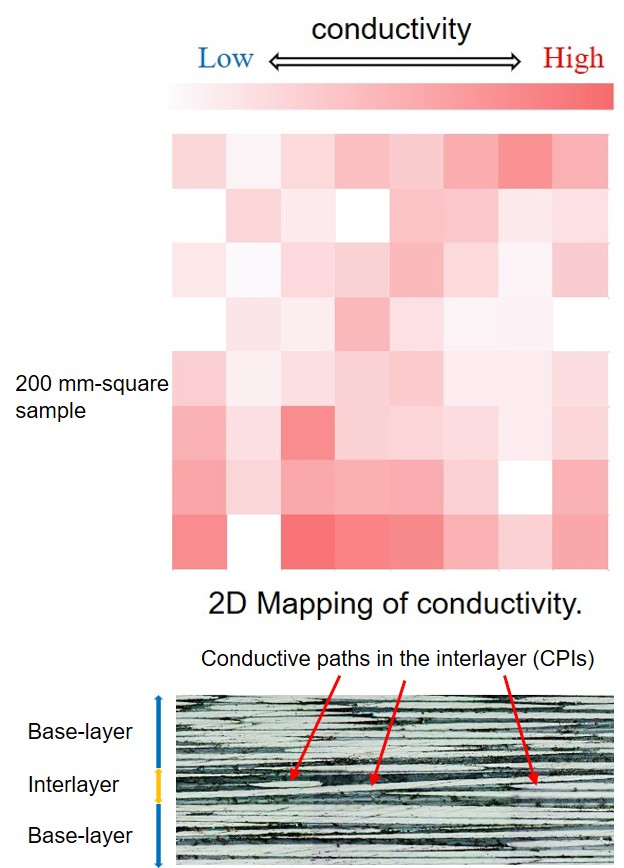How Specimen Size Affects Vertical Conductivity in CFRP Laminates with Interlayers?
Smaller CFRP specimens show greater variability in electrical conductivity due to interlayer structure
How small is too small to trust a measurement? This study shows that in CFRP laminates with interlayers, tiny samples can give misleading electrical readings due to random fiber paths between layers. By modeling this variability, the researchers found a way to predict conductivity from just a few small pieces—helping engineers design safer, smarter carbon fiber components for aircraft and beyond.
Can a small piece of carbon fiber reveal a hidden truth about aerospace safety?
Carbon fiber reinforced plastics(CFRPs)are essential materials in modern aircraft, valued for their strength, light weight, and resistance to fatigue. But they hold another, often overlooked, property:electrical conductivity. This trait is increasingly used in health monitoring systems and lightning protection. However, what if the electrical performance of a CFRP component depended not just on its design, but on how big a sample you test?
In a recent study from Ehime University and Tokyo Metropolitan University, researchers cut large CFRP laminate plates with interlayer toughening into smaller and smaller pieces—down to just 11 mm square. They discovered something curious:while the average vertical(through-thickness)conductivity stayed relatively constant, the variability of conductivity grew dramatically in smaller specimens.
The culprit? Randomness. In these interlayer-tounghened CFRP structures, conductive fibers sometimes cross between layers, forming what we call CPIs—Conductive Paths in the Interlayer. But these paths aren’t neatly arranged;they form unpredictably during the molding process. In small specimens, even cutting a single CPI can skew the measurement, making the conductivity seem much lower—or higher—than expected.
To make sense of this, the team built a probabilistic model showing how the conductivity distribution changes with specimen size. Their model, which shifts from a log-normal to a normal distribution as the area increases, accurately predicts the variability seen in experiments. That means engineers can now estimate the electrical properties of full-sized CFRP components without needing to test huge numbers of large samples.
This matters. From predicting how a wing will handle a lightning strike, to designing sensor systems embedded in fuselage panels, accurate conductivity data is critical. And thanks to this work, we now understand that how you slice a CFRP sample can change the story it tells.
So next time someone hands you a square of aerospace-grade carbon fiber, don’t just look at what’s on the surface. Its electrical secrets might depend on how big a piece you’re holding.
Reference URL: https://doi.org/10.1016/j.compositesa.2025.108943
Bibliographic Information
Title:Effect of specimen surface area on through-thickness electrical conductivity in unidirectional CFRP laminates with interlayers
Authors:Keiji Ogi, Ryotaro Ozaki, Koichi Mizukami
Journal:Composites Part A, 194, 108943
DOI:10.1016/j.compositesa.2025.108943, 2025(July)
Fundings
- Japan Society for the Promotion of Science(JSPS)KAKENHI Grant Number 21K03751
Media
-

Figure 1. Two-dimensional mapping of through-thickness conductivity
The conductivity exhibits a two-dimensional spatial distribution across the laminate, which explains the size dependence observed in the variability of conductivity. This spatial distribution is attributed to the conductive paths in the interlayers(CPIs).
credit : Keiji Ogi(Ehime University)
Usage Restriction : Please get copyright permission -

Figure 2. Effect of specimen size on the mean and variability of conductivity
The mean conductivity remains independent of specimen size, whereas the coefficient of variation(CV)decreases with increasing size.
credit : Keiji Ogi(Ehime University)
Usage Restriction : Please get copyright permission
Contact Person
Name : Keiji Ogi researchmap
Phone : +81-89-927-9707
E-mail : ogi.keiji.mu@ehime-u.ac.jp
Affiliation : Graduate School of Science and Engineering
